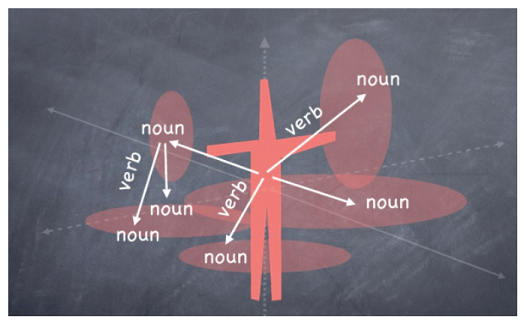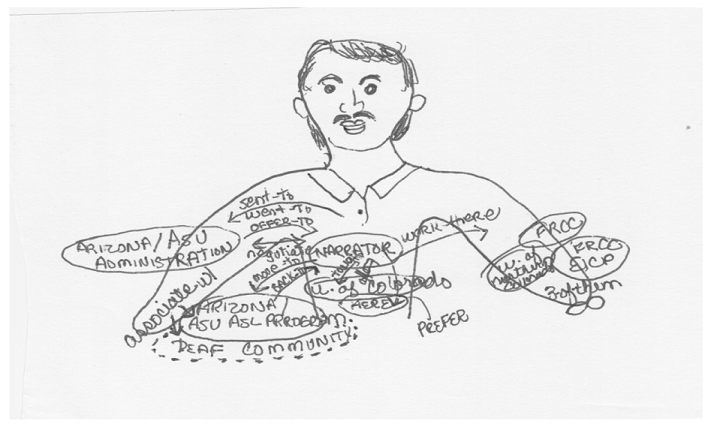General Interpreting Skill Development:
Improving Spatial Structuring - Verbs
This guide enhances general interpreting skills by exploring spatial mapping of verbs and providing activities to improve verb agreement and distribution. Resources that include ASL and English narratives are provided below.
Learners can practice tracking verbs in ASL messages by creating spatial maps.
The strategy of spatial mapping involves the following steps:
- Select an ASL text and watch it for comprehension.
- On a sheet of paper, draw a stick-figure of the signer from the waist up [torso],
inclusive of torso, shoulders, arms, neck and head.
- Watch the ASL text again, and map onto the stick-figure, the zones / areas around
the body where people, locations, events and things are placed and talked about.
You can represent the zone / area with an oval shape circle. These typically will be located directly in front of the signer, or slightly away from the signer’s center, to the left side or right side of the signer, etc.
- In one or two words, place a label in the zone that identifies what that space represents - for example, work location, home, school, reunion, meeting, etc.
- Next, map the verbs that move from the signer to each zone, or from each zone back
to the signer, or from one zone to another.
You can do this using lines with arrows. The line will be drawn from the location where the directional verb begins and the arrow head will point to the location where the directional verb moves to. For example, if the signer talks about going to some event established in one of the zones, then the line would start on the signer’s torso and move to the zone and the arrow head would be placed within the zone. Or, if someone moves from the zone on the signer’s left to a zone on the signer’s right, start the line in the left-side zone, extend it to the right-side zone and place an arrow head at the end.
Here is an image of what the end result might look like. This graphic only shows the verbs going in one direction - from the signer to the zone. However, in many texts, the verbs will also move from the zone to the signer.
Exercise A
Try mapping an ASL text and apply this process. View the following ASL video (2:10 minutes in length). In the video, the signer - Tom Riggs - is discussing a relocation from one state to another due to a job. Don’t be overly concerned about the specific details - such as the universities he names or the states involved. Instead, focus on how he organizes information in space, and specifically the verbs he uses. Chart the main spaces and the direction of verbs to and from those spaces.
TR Work Relocation
posted by Anna Witter-Merithew
~2 minutes in length
When you are finished, you should have a mapping that looks something like this.
What verbs did you identify? How do your findings fit with the list that follows?
Examples of Verb Agreement
- He sent his application and vitae to Arizona State University (ASU)
- ASU summoned-to-him for an interview
- He went-to ASU for the interview
- He returned-to Colorado and waited to hear from ASU
- ASU offered-to-him the job
- They negotiated the salary
- He moved-to Arizona
- He returned-to Colorado in the summer
Examples of Spatial Verbs
- He taught-there at University of Colorado
- He had to wait for the class to make before being offered a contract
- He interviewed at ASU
- He worked in the ASL Dept. at ASU
- He taught and developed curriculum there
- He associated with peers in the Department
- He associated within the Deaf Community in the area
- He preferred the weather in Colorado
- He stayed in Arizona during the 9-month academic year
- He went-to/came-to Colorado for 3-months in the summer
- During the summer, he worked-there FRCC, University of Northern Colorado, and FRCC-EICP
- He enjoys Colorado
View the text as often as you would like until you feel confident that you are able to see each of the specific zones / areas and what is referenced in each, the verbs that show action from him as the narrator to that zone / area and from that zone / area to him, as well as the spatial verbs.
Then, generate an interpretation of the text. Practice it a few times until you are satisfied you have a solid representation of the information. Then, conduct a self-assessment of your performance. Were you successful in accurately interpreting the verbs and maintaining the appropriate agreement? Where could you make improvements? Seek feedback from a mentor and/or peer as well. Use this feedback, along with your own assessment, to re-do the interpretation.
Repeating this process with a variety of texts will heighten your awareness of verb forms and verb agreement in ASL. This can strengthen your ASL to English interpretations.
Exercise B
Apply the steps outlined in Exercise A to a new ASL text.
Sign with Robert - New Used Car Story
posted by Hilari Scarl
~3 minutes in length
Step 1. Watch the ASL text.
Step 2. List the main ideas of the text.
Step 3. Map the spatial structuring that occurs in the text.
What zones / areas are used around the signer’s body? What information is established in the zones / areas? What directional and spatial verbs are used? How do they relate from the signer to the zone / area or from the zone / area to the signer?
Review the completed map to identify the inter-relatedness of ideas and how the overall message fits together.
Step 4. Record yourself interpreting the text, applying cross-linguistic features to convey the verb forms in spoken English.
Review your performance against the spatial map and assess your effectiveness in conveying all the intended connections. Are there areas where you could improve your performance as it relates to verb forms as part of spatial structuring? If so, where and why?
Step 5. Seek feedback from a peer and/or mentor. Incorporate this feedback, along with your own observations from the self-assessment, and re-do your interpretation.
Step 6. Apply steps 1-5 to a range of ASL texts involving different speakers and a variety of topics.
Resources
NOTE: These resources were last updated March 2021.
A PDF version of this guide is available - General Interpreting Skill Development: Verbs
Grant Recognition
The contents of the Project CLIMB website was developed under a grant (#H160D160001) from the Department of Education. The contents do not necessarily represent the policy of the Department of Education. Do not assume endorsement by the Federal government.
As of December 31, 2021, this grant project is no longer active or soliciting applications.
This website will remain available as a resource.

The National Clearinghouse of Rehabilitation Training Materials (NCRTM) website is a central portal for accessing archived and new rehabilitation training resources offering search capabilities, a quality rating system, as well as enhanced usability and accessibility.



